Complete Solutions to EXERCISE of chapter QUADRILATERALS of Class 9 book with complete answers and questions
| Class 9 | MATHS |
| Chapter | QUADRILATERALS |
| NCERT TELUGU | EXERCISE |
| Number Of Questions | 80 |
| Academic Year | 2023-24 |
State whether the statements are True or False.
(i) Every parallelogram is a trapezium ( )
View SolutionState whether the statements are True or False.
(ii) All parallelograms are quadrilaterals ( )
View SolutionState whether the statements are True or False.
(iii) All trapeziums are parallelograms ( )
View SolutionState whether the statements are True or False.
(iv) A square is a rhombus ( )
View SolutionState whether the statements are True or False.
(v) Every rhombus is a square ( )
View SolutionState whether the statements are True or False.
(vi) All parallelograms are rectangles
View SolutionComplete the following table by writing (YES) if the property holds for the particular Quadrilateral and (NO) if property does not holds.
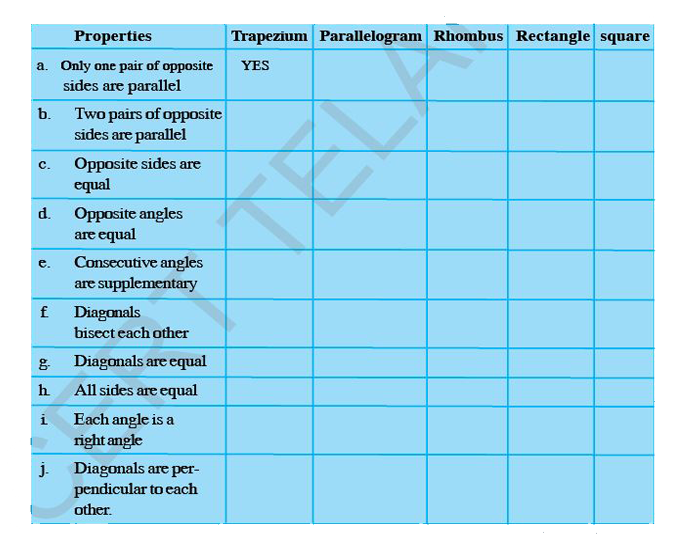
View SolutionABCD is trapezium in which `AB"||"CD`. If `AD =BC`, show that `angleA=angleB` and `angleC and angleD`.
View SolutionThe four angles of a quadrilateral is in the ratio of 1: 2:3:4. Find the measure of each angle of the quadrilateral.
View SolutionABCD is a rectangle AC is diagonal. Find the nature of `DeltaACD`. Give reasons.
View SolutionIn the adjacent figure ABCD is a parallelogram ABEF is a rectangle show that `DeltaAFD~=DeltaBEC`.
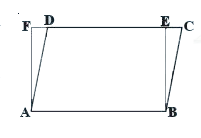
View SolutionShow that the diagonals of a rhombus divide it into four congruent triangles.
View SolutionIf a quadrilateral ABCD, the bisector of `angleC angleD` intersect at O.
Prove that `angleCOD=(1)/(2)(angleA+angleB)`
View SolutionThe opposite angles of a parallelogram are `(3x-2)^@` and `(x+48)^@`. Find the measure of each angle of the parallelogram.
View SolutionFind the measure of all the angles of a parallelogram, if one angle is `24^(@)` less than the twice of the smallest angle.
View SolutionIn the adjacent figure ABCD is a parallelogram and E is the midpoint of the side BC. If DE and AB are produced to meet at F, show that `AF=2AB`.
View SolutionIn the adjacent figure a parallelogram and P, Q are the midpoints of sides AB and DC respectively. Show that PBCQ is also a parallelogram.
View SolutionABC is an isosceles triangle in which `AB = AC. AD` bisects exterior angle `QAC and CD "||" BA` as shown in the figure. Show that
(i) `angleDAC = angleBCA`
(ii) ABCD is a parallelogram
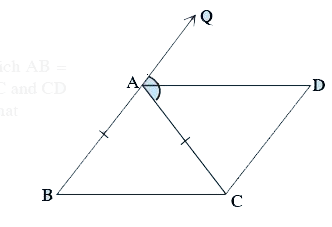
View SolutionABC is an isosceles triangle in which `AB = AC. AD` bisects exterior angle `QAC and CD "||" BA` as shown in the figure. Show that
(i) `angleDAC = angleBCA`
(ii) ABCD is a parallelogram

View SolutionABCD is a parallelogram and AP and CQ are perpendicular from vertices A and C on diagonal BD (see figure) show that : `/_\APB` ~= `/_\CQD`
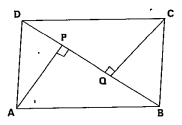
View SolutionABCD is a parallelogram AP and CQ are perpendiculars drawn from vertices A and C on diagonal BD (see figure)..Show that : i) `DeltaAPB = DeltaCQD`.
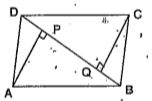
View SolutionIn `Delta^s` ABC and DEF, DE and `AB || DE`, `BC=EF` and `BC || EF`. Vertices A, B and C are joined to vertices D, E and F respectively (see figure). Show that : ABED is a parallelogram.
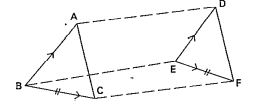
View SolutionIn `Delta^s` ABC and DEF, DE and `AB || DE`, `BC=EF` and `BC || EF`. Vertices A, B and C are joined to vertices D, E and F respectively (see figure). Show that : BCFE is a parallelogram.
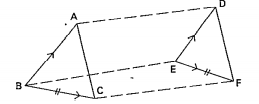
View SolutionIn `Delta^s` ABC and DEF, DE and `AB || DE`, BC=EF and `BC || EF`. Vertices A, B and C are joined to vertices D, E and F respectively (see figure). Show that :` AC=DF`
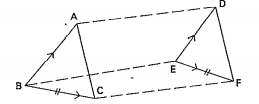
View SolutionIn `Delta^s` ABC and DEF, DE and `AB || DE`, BC=EF and `BC || EF`. Vertices A, B and C are joined to vertices D, E and F respectively (see figure). Show that : `/_\ABC` ~= `/_\DEF`
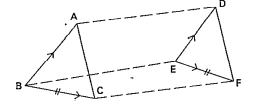
View SolutionABCD is a parallelogram. AC and BD are the diagonals intersect at O. P and Q are the points of tri section of the diagonal BD. Prove that `CQ" ||" AP` and also AC bisects PQ (see figure).
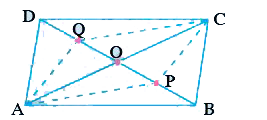
View SolutionABCD is a square. E, F, G and H are the mid points of `AB, BC, CD and DA` respectively. Such that `AE = BF = CG = DH`. Prove that EFGH is a square.
View SolutionDraw a triangle ABC and mark the midpoints E and F of two sides of triangle. `bar(AB) and bar(AC)` respectively. Join the point E and F as shown in the figure.
Measure EF and the third side BC of the triangle. Also measure `angleAEF and angleABC`.
We find `angleAEF = angleABC and bar(EF)=(1)/(2)bar(BC)`
As these are corresponding angles made by the transversal AB with lines EF and BC, we say `EF"||"BC.`
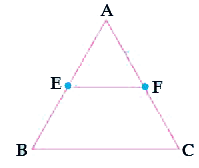
View SolutionABC is a triangle . D is a point of AB such that `AD=(1)/(4)AB and E` is a point on AC such that `AE=(1)/(4)AC.` If `DE =2cm` find BC.
View SolutionABCD is quadrilateral E, F, G and H are the midpoints of `AB, BC, CD and DA` respectively. Prove that EFGH is a parallelogram.
View SolutionShow that the figure formed by joining the midpoints of sides of a rhombus successively is a rectangle.
View SolutionIn a parallelogram ABCD, E and F are the midpoints of the sides AB and DC respectively. Show that the line segments AF and EC trisect the diagonal BD.
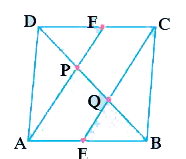
View SolutionShow that the line segments joining the midpoints of the opposite sides of a quadrilateral and bisect each other.
View SolutionABC is a triangle right angled at 'C'. A line through the midpoint M of hypotenuse AB and parallel to BC intersects AC at D. Show that : D is the midpoint of AC.
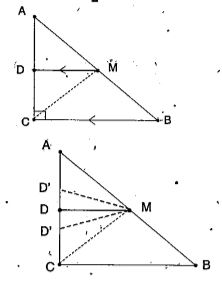
View SolutionABC is a triangle right angled at C. A line through the midpoint M of hypotenuse AB and parallel to BC Intersects AC at D. Show that : `MD_|_ AC`
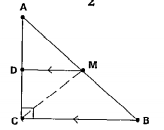
View SolutionABC is a triangle right angled at 'C'. A line through the midpoint M of hypotenuse AB and parallel to BC intersects AC at D. Show that : `CM = MA = 1/2 AB` .
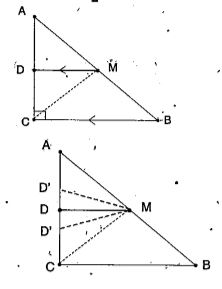
View SolutionABCD is a parallelogram and P is a point of `bar(CD)`. Show that `ar(/_\ABP)` = `ar(/_\ADP+ /_\BCP)`.
View SolutionPQRS is a parallelogram. K. L are the midpoints on PQ, RS respectively. `bar(PL)` intersects `bar(SK)` at M and RK and QL intersects at N. Show that KNLM is a parallelogram.
View SolutionABCD is a parallelogram and P, Q are the mid points of `bar(AD)` and `bar(BC)` respectively such that AP=1/3AD and CQ=1/3BC,Show that : AQCP is a parallelogram.
View SolutionABCD is a parallelogram and P, Q are the mid points of `bar(AD)` and `bar(BC)` respectively. Show that : `bar(BD)` and `bar(PQ)` bisect each other.
View SolutionIn `/_\ABC`, AD is the median on `bar(BC)`. 'E' is the midpoint of AD. Draw `bar(BF)` through E. Show that `AF = `1/3`AC`
View SolutionIn a Parallelogram PQRS, `/_SPQ=70^@ and angle SQR=65^@`. Find the other angles of the parallelogram.
View SolutionIn a parallelogram ABCD, `angleABC=50^@`.Find the other angles.
View SolutionThe four angles of a quadrilateral is in the ratio of 3:4:5: 6. Find the measure of each angle.
View SolutionThe four angles of a quadrilateral is in the ratio of 2 : 3:5: 8. Find the measure of each angle.
View SolutionThe opposite angles of a parallelogram are `(2x - 3)^@` and `(x + 4)^@`. Find each angle of its angles.
View SolutionIn `/_\ABC`, P, Q, R are the mid points of `bar(AB), bar(BC), bar(CA)` respectively. If area of `/_\POR=3` sq. units. Find the area of the `/_\ABC`.
View SolutionThe sum of the measures of two con secutive sides of a parallelogram is 18 cm. Find its perimeter.
View SolutionIn `/_\ABC`, D, E, F are the mid-points of `bar(AB)`, `bar(BC)`, `bar(CA)` and if `bar(AB)`= 11 cm, `bar(BC)` = 9 cm, `bar(CA)` = 8cm. Find the lengths of `bar(DE)`, `bar(EF)` and `bar(DF)`.

View SolutionIn `/_\PQR`, A, B, C are the mid-points of `bar(PQ), bar(QR), bar(RP)` and if AB=4 cm, BC=6cm, AC=5cm. Find `bar(PQ), bar(QR), bar(RP)`.
View SolutionABCD is a trapezium. AB || CD, P, Q are the mid-points AD and BC respectively. If` AB=10cm, `CD=18 cm, then PQ=?
View SolutionKLMN is a trapezium and KL || MN. P, Q are the midpoints of KN and LM respectively. If `KL=18 cm, `PQ=10 cm, Find MN=?
View SolutionABC is a triangle . D is a point of AB such that `AD=(1)/(4)AB and E` is a point on AC such that `AE=(1)/(4)AC.` If `DE =2cm` find BC.
View SolutionIn `triangleKLM`, P is the midpoint of KL. such that KP = `1/4`KL and Q is the midpoint on KM such that KQ=`1/4`KM and if PQ =11 cm. Find LM?
View SolutionAny two consecutive angles of a parallelogram are
View SolutionShow that the diagonals of a square are equal and right bisectors of each other.
View SolutionIf a parallelogram has its sides equal and each angle is `90^@`, then it is called_____.
View SolutionIn a parallelogram PQRS, if `/_P` = `70^@`, then `/_R`= _____.
View SolutionIf two adjacent sides of a parallelogram are `3.5`, `6 cms`. Then its perimeter is ___.
View SolutionThe angle bisectors of a parallelogram form a
View SolutionIn the adjacent figure ABCD is a parallelogram angle A=50^@ and angle c=?
View SolutionIn `/_\ABC`, `bar(AD) and bar(BE)` are the midpoints of `bar(BC)` and `bar(AC)`. If `AC=10 cm`, then CE =
View SolutionABCD is a trapezium in which `AB||CD`. P and Q are midpoints of `bar(AD)` and`bar(BC)` respectively. If `AB=10 cm, `PQ=8 cm, then `CD=____`.
View SolutionIn a figure `bar(PQ)`|/|`bar( BC)` and P, Q are midpoints of `bar(AB)`, `bar(AC)` respectively. If `PQ=4cm`, then `BC=_____`.
View SolutionFill in the Blanks :A figure formed by joining the mid points of a parallelogram is_________
View SolutionFill in the Blanks:If the mid-points of the sides of a square are joined the figure so formed is____
View SolutionFill in the Blanks:The sum of four angles in a quadrilateral is_______right angles.
View SolutionFill in the Blanks:In a parallelogram PQRS, the bisectors of consecutive angles P and Q intersect at K.`angle PKQ`=____.
View SolutionThe angles of a quadrilateral are in ratio of 2:3:4:6. Find the measure of smallest angle.
View SolutionA parallelogram in which two adjacent sides are
equal is a ……….
View SolutionFill in the Blanks:The diagonals of a rhombus divide it into____ congruent angles.
View SolutionFill in the Blanks:The diagonals of a rectangle are of____
View SolutionFill in the Blanks:The diagonals of a square are equal and__________each other.
View SolutionFill in the Blanks:The ratio of areas of a triangle and 9 par allelogram are on the base and between the same parallel lines is______
View SolutionABCD is a parallelogram and P is a point of `bar(CD)`. Show that `ar(/_\ABP)` = `ar(/_\ADP+ /_\BCP)`.
View SolutionIf `A=45^o` then find the value of `tan2A`.
View SolutionIn a parallelogram ABCD, `angleABC=50^@`.Find the other angles.
View SolutionThe four angles of a quadrilateral is in the ratio of 2: 3:5:8. Find the measure of each angle.
View SolutionIf the sum of two adjacent sides of a parallelogram is 32 cm. Find its perimeter.
View SolutionIn `triangleKLM`, P is the midpoint of KL. such that KP = `1/4`KL and Q is the midpoint on KM such that KQ=`1/4`KM and if PQ =11 cm. Find LM?
View Solution
EXERCISE questions and complete solutions for chapter QUADRILATERALS of NCERT Maths(Telugu) of Class 9